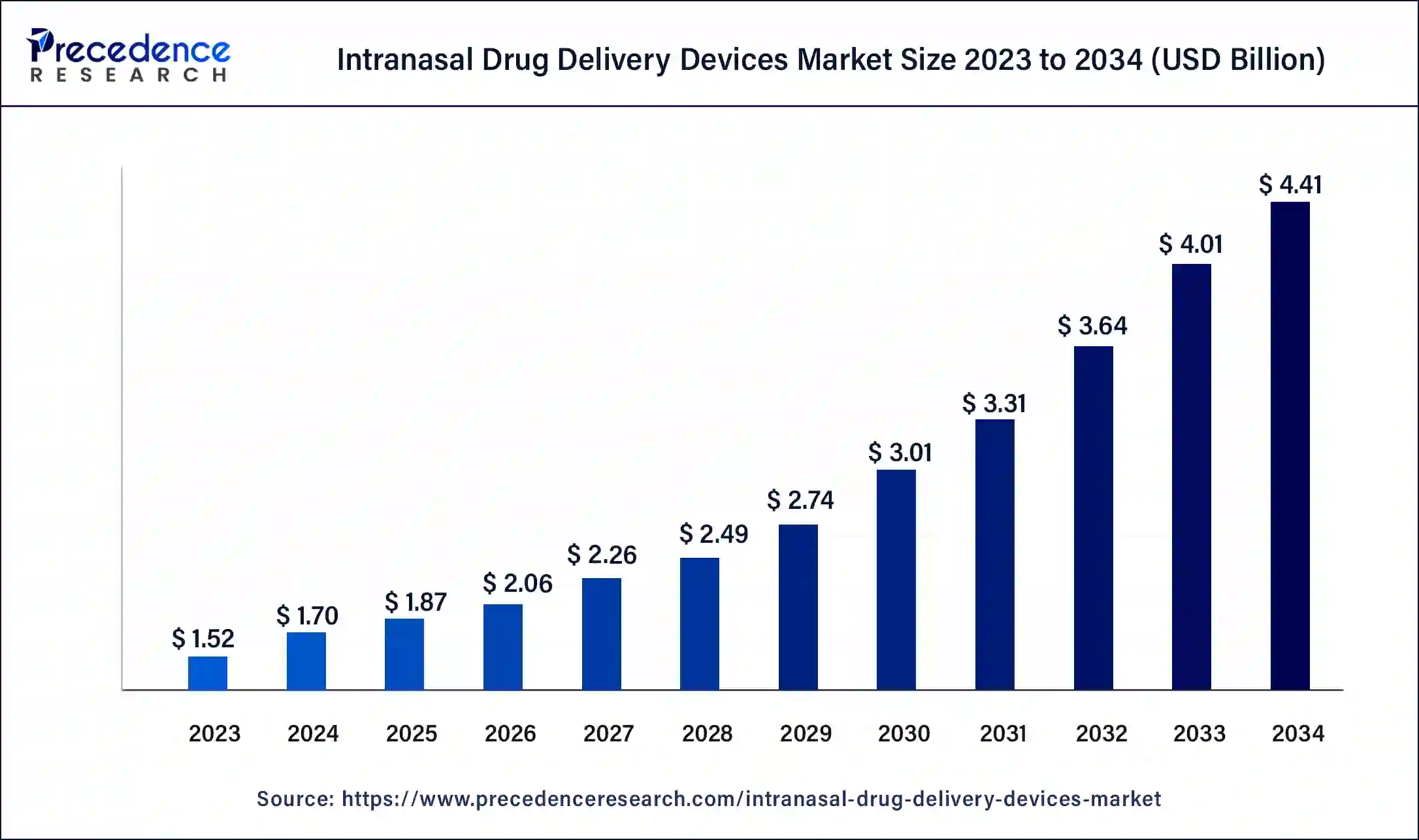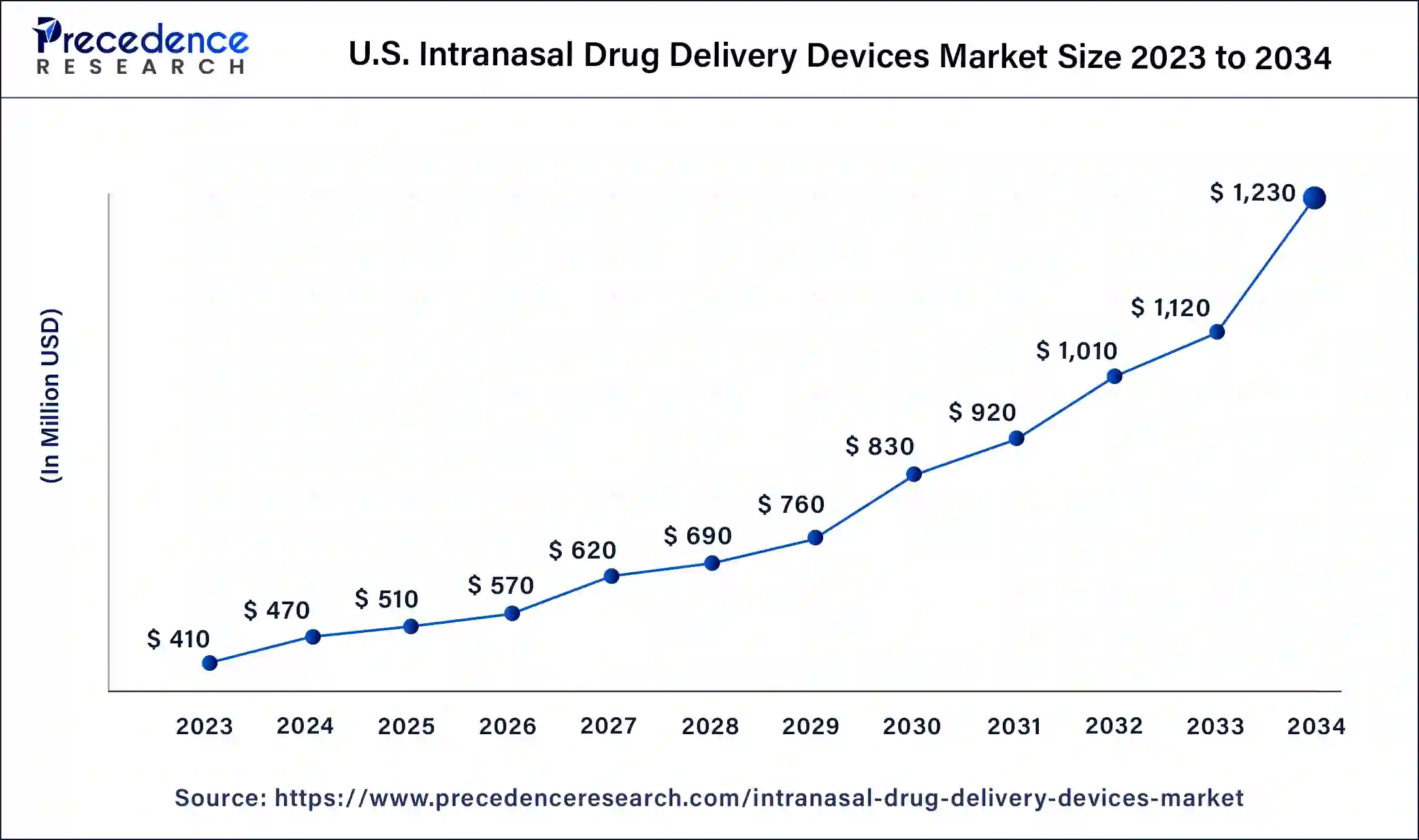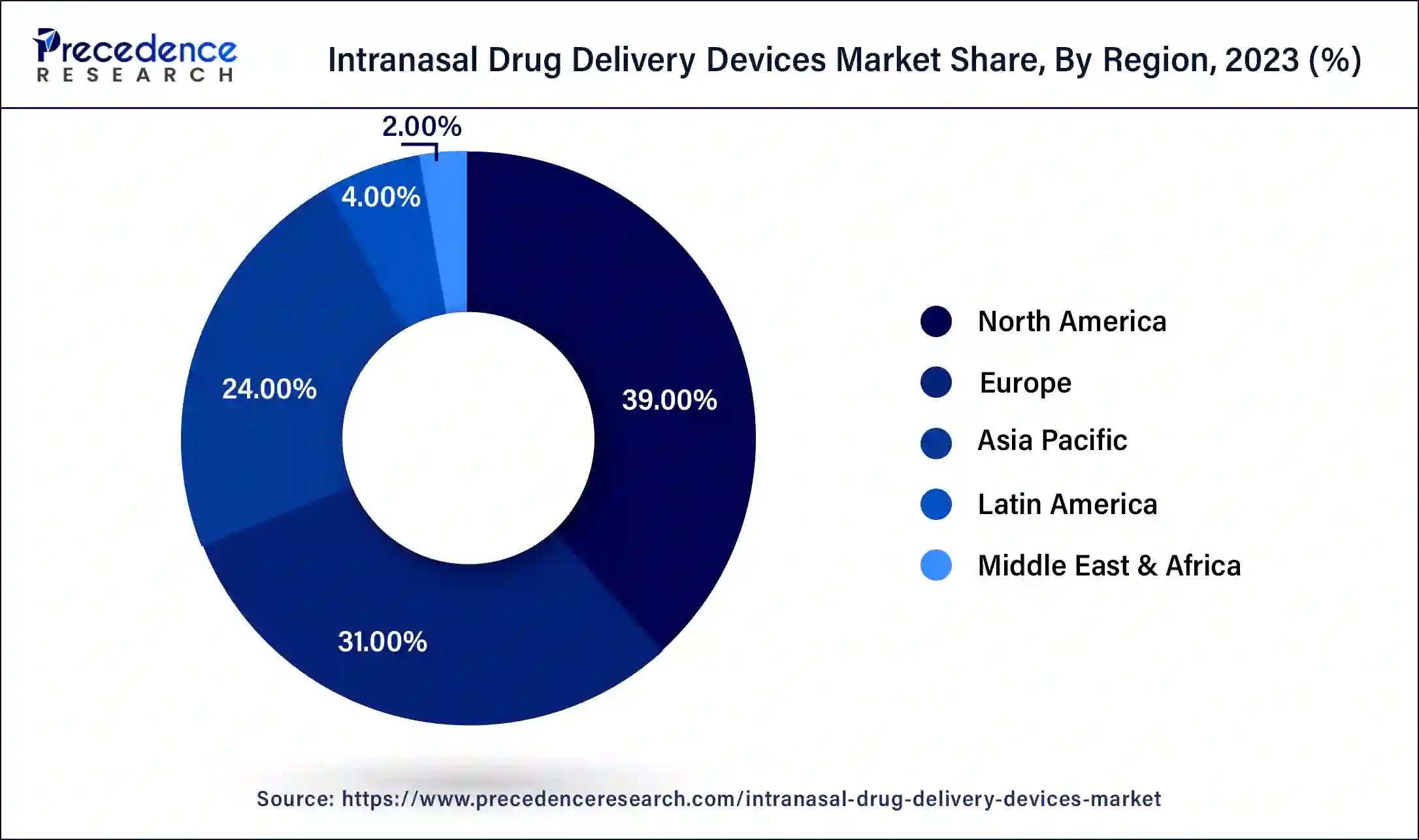June 2023
The global intranasal drug delivery devices market size was USD 1.52 billion in 2023, calculated at USD 1.70 billion in 2024 and is expected to reach around USD 4.41 billion by 2034, expanding at a CAGR of 10% from 2024 to 2034.
The global intranasal drug delivery devices market size accounted for USD 1.70 billion in 2024 and is expected to reach around USD 4.41 billion by 2034, expanding at a CAGR of 10% from 2024 to 2034. The North America intranasal drug delivery devices market size reached USD 590 million in 2023.

The U.S. intranasal drug delivery devices market size was estimated at USD 410 million in 2023 and is predicted to be worth around USD 1,230 million by 2034, at a CAGR of 10.1% from 2024 to 2034.

The research report covers key trends and prospects of intranasal drug delivery devices products across different geographical regions including North America, Europe, Asia-Pacific, Latin America, and Middle East and Africa. Geographically, intranasal drug delivery devicesmarket is conquered by North America owing to high incidence of asthma and presence of sophisticated healthcare framework. On the other hand, Asia-Pacific is anticipated to witness the rapid growth rate, on account of increasing healthcare expenditure and growing investment by major manufactures to launch new products.

| Report Highlights | Details |
| Market Size in 2023 | USD 1.52 Billion |
| Market Size in 2024 | USD 1.70 Billion |
| Market Size by 2034 | USD 4.41 Billion |
| Growth Rate from 2024 to 2034 | CAGR of 10% |
| Base Year | 2023 |
| Forecast Period | 2024 to 2034 |
| Segment Covered | System, Container, Application, End User, and Regions |
| Regions Covered | North America, Asia Pacific, Europe, Latin America, Middle East and Africa |
Major Trends in the Intranasal Drug Delivery Devices Industry:
Considering the wide-ranging awareness in nasal drug delivery and the possible advantages of intranasal administration, it is anticipated that novel nasal drug delivery products will continue to arrive at the market and advance exponentially in the forthcoming years. The prospects in the worldwide market for the intranasal drug delivery devices have drawn huge expenditure by major companies in research and development activities. Moreover, in the emerging countries such as India, China, etc. having low labor and clinical trials costs, will further aidin drawing market players to these nations and will observe an exponential development in the forthcoming years. The novel nasal drug delivery devices are expected to reach the market and grow significantly in the upcoming years due to the prevalent awareness regarding nasal drug delivery and the probable advantages of intranasal administration. The prospects in the global market for the intranasal drug delivery devices have invited huge investments by key companies in the research and development activities. Furthermore, in the emerging economies in the Asia Pacific region, which have lower costs of clinical trials and labor, will further help to draw market players to this region and will observe an exponential development in the near future. Through the development of spontaneous patient-friendly modernizations, intranasal medication delivery devices and apparatuses enable treatments to remain on the cutting edge along with making life better for affected individuals, thereby offering a great prospect for its overall business to flourish in the forthcoming years. To take completebenefit of these openings offered by nasal delivery of medications, innovative methods to overcome the biological blockades to delivery are being established. The technological advancements in many of the nasal drug transfer devices currently, consists of the powder preparation and carrier technology, intended for increased medication absorption through its muco-adhesive features and a transfer device technology intended for simple use, and comprehensive and consistent transfer of intranasal powder preparations. This technology can be employed to a wide range of medications, including peptides, small molecules, and biologics.
Multi-dose Systems Segment Reported Foremost Market Stake in 2023
Multi-dose systems segment recorded the prime market share in the global intranasal drug delivery devices market in 2023. The ability of multi-dose systems to deliver drugs by avoiding formulation contamination is the major reason for high market share of multi-dose systems. The factors such as better tolerance and efficient use are expected to increase the usage of the multi-dose intra-nasal drug delivery systems over the estimate period.
The metered dose systems are projected grow at the highest CAGR during the forecast period mainly due to new product launches.
Asthma is Projected to Dominate the Application Segment of Intranasal Drug Delivery Devices Market Revenue
Intranasal drug delivery devices are rapidly being employed for the management of asthma. As per the Centers for Disease Control and Prevention (CDC), 1 in 13 persons have asthma.Thus, high incidence of asthma and ongoing research and development activity in intranasal drug delivery devices for better absorption is the major reason for the high revenue share of asthma.
Rhinitissegment will expand at a significant CAGR during the forecast time-frame.
Hospitals Projected to Dominate the End-User Segment of Intranasal Drug Delivery Devices Market Revenue
Hospitals have a high flow of patients with respiratory disorders when compared to small clinics. Furthermore, hospitals have capital availability to procure latest equipment’s. These factors contribute to the growth of hospital segment.
Major Market Segments Covered:
By System
By Container
By Application
By End User
By Geography
North America
Europe
Asia Pacific
Latin America
Middle East & Africa (MEA)
For inquiries regarding discounts, bulk purchases, or customization requests, please contact us at sales@precedenceresearch.com
No cookie-cutter, only authentic analysis – take the 1st step to become a Precedence Research client
June 2023
January 2025
November 2024
January 2025